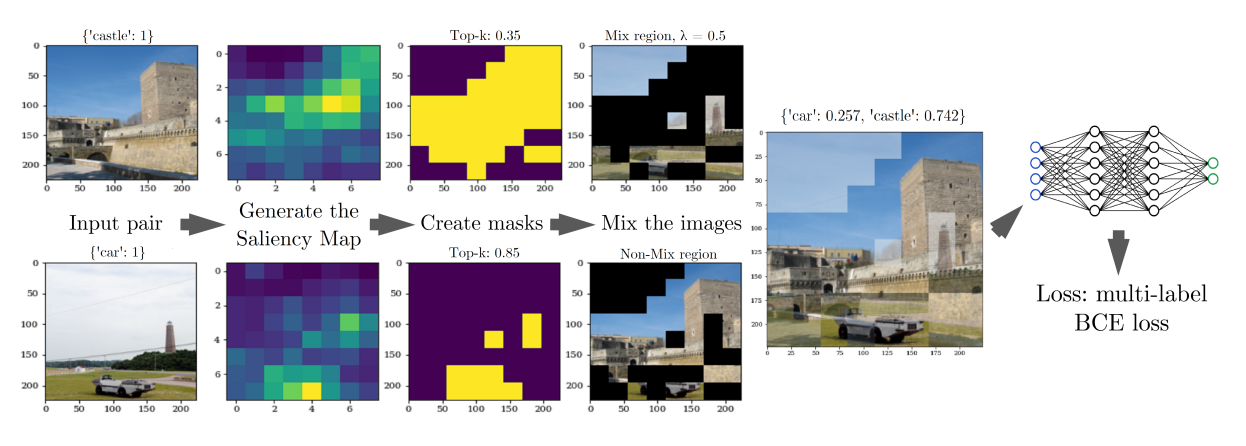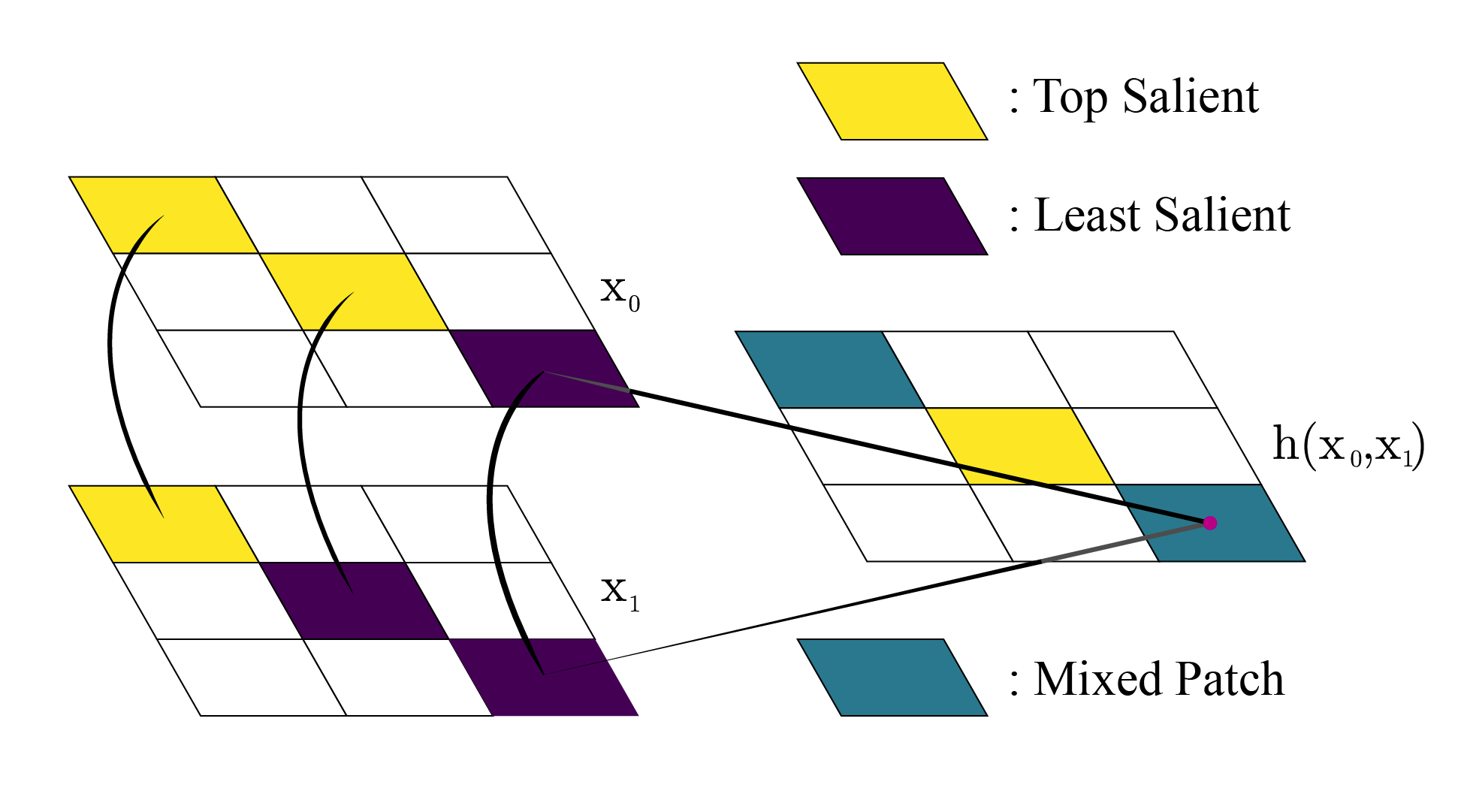This is the official code release for the paper "Expeditious Saliency-based Mixup through Random Gradient Thresholding", accepted at 2nd International Workshop on Practical Deep Learning in the Wild (Practical-DL) at AAAI Conference on Artificial Intelligence 2023.
by Minh-Long Luu, Zeyi Huang, Eric P. Xing, Yong Jae Lee, and Haohan Wang.
Our work, R-Mix, combines randomization through saliency-guided training of mix-up, which has shown to have a large improvement over CutMix and cuts down training time.
In addition to dependencies listed in requirements.txt file, the code is tested with:
- Python 3.7+
- torch 1.7.1
- torchvision 0.8.2
- CUDA 11.0
- Ubuntu 18.04 (for ImageNet experiments)
The code is also tested with PyTorch 1.9. Simply install the requirements from the file:
# Install dependencies
pip install -r requirements.txtIf one wants to run ImageNet experiments, Apex is required. We use the codebase from Co-Mixup. With 4 RTX 2080Ti, it is expected to take about 5 days, and with 4 A6000, it takes about 1 day.
sh main_fast_ddp.sh /path/to/size160 /path/to/size352 rmixWe provide the pretrained models at this link: Google Drive. Last checkpoints showed:
| Model (Dataset) | Top-1 Accuracy |
|---|---|
| PreActResNet18 (CIFAR-100), CutMix+ | 81.62 |
| WideResNet28-10 (CIFAR-100), CutMix+ | 83.53 |
| PreActResNet18 (CIFAR-100), R-Mix | 81.45 |
| WideResNet16-8 (CIFAR-100), R-Mix | 82.32 |
| WideResNet28-10 (CIFAR-100), R-Mix | 84.95 |
| ResNeXt29-4-24 (CIFAR-100), R-Mix | 83.02 |
| ResNet-50 (ImageNet), R-Mix | 77.39 |
We further improve CutMix+ to be even better than reported in the paper of PARN, but it is still fall short on bigger models.
To validate the result, use the following preprocessing code (requirements.txt dependencies should be installed):
import torch
from torchvision import transforms
from torchvision import datasets
import torchmetrics
from torchmetrics import MetricCollection
device = "cuda"
def calculate_metrics(model, dataloader):
metrics = MetricCollection({
"acc1": torchmetrics.Accuracy(top_k=1).to(device),
"acc5": torchmetrics.Accuracy(top_k=5).to(device),
})
model.eval()
with torch.no_grad():
for images, labels in dataloader:
outputs = model(images.to(device))
metrics(torch.nn.Softmax(dim=1)(outputs), labels.to(device))
print(f"{metrics.compute()}")
batch_size = 100
mean = [x / 255 for x in [129.3, 124.1, 112.4]]
std = [x / 255 for x in [68.2, 65.4, 70.4]]
test_transform = transforms.Compose([
transforms.ToTensor(),
transforms.Normalize(mean, std)
])
cifar100_test = datasets.CIFAR100(root='./data', train=False,
download=True, transform=test_transform)
test_loader = torch.utils.data.DataLoader(cifar100_test,
batch_size=batch_size,
shuffle=False)
from model.preactresnet import preactresnet18
model = preactresnet18(100, stride=1) # Can use our code to initialize this model
checkpoint = torch.load('../<file>.pth.tar')
from collections import OrderedDict
new_state_dict = OrderedDict()
for k, v in checkpoint['state_dict'].items():
name = k[7:] # remove `module.`
new_state_dict[name] = v
model.load_state_dict(new_state_dict)
model.to(device)
calculate_metrics(model, test_loader)For ImageNet, simply use model = torch.load(...) to load the tar file, and use model.keys() to get the detailed information.
Accuracies are different when evaluating on CPU and GPU. Please use GPU to validate the results.
Detailed descriptions of Argument Parser are provided in parse_args.py file. Hyperparameters are set to the best.
To reproduce R-Mix with OneCycleLR, use:
python main.pyTo reproduce RL-Mix with OneCycleLR, use:
python main.py --method rlmixTo reproduce the result with MultiStepLR, change the scheduler argument:
python main.py --scheduler MultiStepLRR-Mix is expected to take about 4 hours, on one NVIDIA Tesla P100-PCIE-16GB and RL-Mix is about 8 hours.
Currently, it only supports stdout log. For a more detailed logging, please use wandb as instructed below.
By default, we use 4 workers. One can change the number of workers in main.py for a fair comparison. However, on a Kaggle session it will
not make a big difference.
Final result may be different due to hardware/CUDA version/PyTorch version. However, on CIFAR-100, it should be at least 80% accuracy.
Please see the folder ./imagenet
We also implement wandb to monitor the training process. To use wandb, simply add 5 additional arguments:
python main.py ... --use_wandb 1 --wandb_key "XXX" --wandb_project "YYY" \
--wandb_entity "ZZZ" --wandb_name "YOUR_RUN_NAME"Replace the key, project, entity and name to your own project.
Simply add --vis_epoch 10 to visualize the mix-up images every 10 epochs. Default to 0, means no visualization.
We also provide a ready-to-use (user can directly copy it to your project) R-Mix. Code is in the
file r_mix.py.
@misc{luu2022expeditious,
title={Expeditious Saliency-guided Mix-up through Random Gradient Thresholding},
author={Minh-Long Luu and Zeyi Huang and Eric P. Xing and Yong Jae Lee and Haohan Wang},
year={2022},
eprint={2212.04875},
archivePrefix={arXiv},
primaryClass={cs.CV}
}
MIT license.

